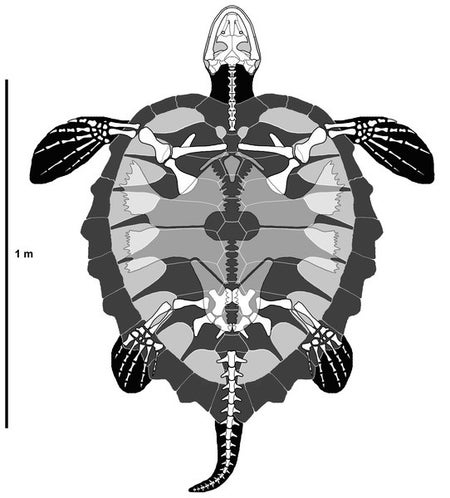This article was published in Scientific American’s former blog network and reflects the views of the author, not necessarily those of Scientific American
When I think of sea turtles, I think of smooth shells. This is probably because the green sea turtle - with its lovely, sleek carapace - has long been the ambassador for these marine reptiles. But, as a fossil sea turtle from the Cretaceous of Alabama reminds us, different scaly swimmers have long displayed a variety of flashy shell shapes. Take Prionochelys matutina, for example - the “sawtooth turtle.”
You may have seen Prionochelys before in a museum exhibit. This turtle has been known to paleontologists since 1953 and has always stood out from its relatives thanks to the tooth-like protrusions along the margins and center of its shell. The effect is fit for a Teenage Mutant Ninja Turtles villain. But, as Andrew Gentry points out in a new study, the actual osteological architecture of this turtle’s shell is relatively unknown. Incomplete specimens and a lack of referred material have left us with an anatomical gap.

The reconstructed skeleton of Prionochelys seen from below. Credit: Gentry 2018
On supporting science journalism
If you're enjoying this article, consider supporting our award-winning journalism by subscribing. By purchasing a subscription you are helping to ensure the future of impactful stories about the discoveries and ideas shaping our world today.
New specimens from the Cretaceous rock of Alabama, representative of a time when a shallow sea straddled the middle of North America, help fill in our understanding of Prionochelys. Multiple specimens of adults and juveniles present the old sawtooth in new detail. The pointed parts of shell around the edges give Prionochelys a more jagged look - more hawksbill than green - and the center ridge displays rounded points that add to the sawtooth impression. The overall effect is a little more subtle than the almost aggressively-ornamented versions that have been reconstructed before.
On top of that, Gentry writes, the new fossils have helped refine how the several known Prionochelys species relate to other seagoing shellbacks. It appears that Prionochelys groups together with several other fossil sea turtles with bumpy backs on the evolutionary stem that connects to the cheloniids, or the group which includes today’s green, loggerhead, and hawksbill sea turtles, among others. This is despite the fact that some of the shell ornamentation anatomy on Prionochelys resembles that of the leatherback sea turtle, which suggests these features evolved twice independently. Prionochelys just took the construction to a sharper extreme.